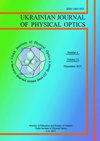新型色散补偿拉曼放大器级联单泵参量放大器用于密集波分复用
IF 8.6
4区 物理与天体物理
0 OPTICS
引用次数: 2
摘要
本文将色散补偿拉曼放大器与单泵参量放大器级联,构建了密集波分复用(DWDM)系统。这种混合系统在l波段表现出平坦的增益。我们的混合系统已经被评估为在189到191.375太赫兹的带宽范围内,以40 Gbps的速度用于25 GHz 96通道系统。结果表明,在不使用增益平坦化技术的情况下,增益大于16.9 dB,增益纹波小于5.82 dB。我们设计的新颖之处在于在长拉曼放大器光纤中结合色散补偿和信号放大,然后在单独的高度非线性光纤上实现短长度参数放大器。在数据速率为10gbps的情况下,无需任何增益补偿技术,可实现的增益纹波低至1.9 dB。光信噪比大于18 dB,增益平坦,证明了我们的拉曼光纤参数放大器可以作为可调宽增益放大器用于未来的长途DWDM系统。并与目前研制的l波段光放大器进行了比较。对比证明我们的放大器是所有现有的类似物中最好的。本文章由计算机程序翻译,如有差异,请以英文原文为准。
New dispersion-compensated Raman-amplifier cascade with a single-pump parametric amplifier for dense wavelength-division multiplexing
In this work a dispersion-compensated Raman amplifier has been cascaded with a single-pump parametric amplifier to build a dense wavelengthdivision multiplexed (DWDM) system. This hybrid system demonstrates a flat gain in the L-band. Our hybrid has been evaluated for a 25 GHz 96-channel system at 40 Gbps in the band spreading from 189 to 191.375 THz. The results demonstrate the gain larger than 16.9 dB and the gain ripple less than 5.82 dB, with no gainflattening technique used. The novelty of our design lies in combining dispersion compensation with signal amplification in a long-length Raman-amplifier fibre followed by a short-length parametric amplifier implemented on a separate highly nonlinear fibre. For the data rate 10 Gbps, the achievable gain ripple is as low as 1.9 dB, without any gain-compensation technique. The optical signal-to-noise ratio larger than 18 dB and the flat gain confirm that our Raman fibre-optic parametric amplifier can be used as a tunable and broad-gain amplifier for the future long-haul DWDM systems. The results obtained for our system have been compared with those of the L-band optical amplifiers developed recently. The comparison testifies that our amplifier is the best of all existing analogues.
求助全文
通过发布文献求助,成功后即可免费获取论文全文。
去求助
来源期刊
CiteScore
9.90
自引率
0.00%
发文量
20
审稿时长
>12 weeks
期刊介绍:
“Ukrainian Journal of Physical Optics” contains original and review articles in the fields of crystal optics, piezo-, electro-, magneto- and acoustooptics, optical properties of solids and liquids in the course of phase transitions, nonlinear optics, holography, singular optics, laser physics, spectroscopy, biooptics, physical principles of operation of optoelectronic devices and systems, which need rapid publication.
The journal was founded in 2000 by the Institute of Physical Optics of the Ministry of Education and Science of Ukraine.

 求助内容:
求助内容: 应助结果提醒方式:
应助结果提醒方式:


